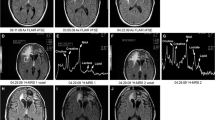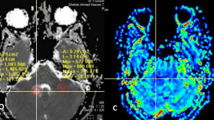Abstract
Objective
To explore the usefulness of multivoxel 3D proton MR spectroscopy (1H-MRS) in assessing the recurrent contrast-enhancing areas at the site of the previously treated gliomas.
Materials and methods
In 28 patients who had new contrast-enhancing lesions in the vicinity of the previously resected and irradiated high-grade glioma, 3D 1H-MRS examinations were performed on a 3.0T MR scanner. Spectral data for N-acetylaspartate (NAA), choline (Cho), and creatine (Cr) were analyzed in all patients. Receiver operating characteristic analysis was performed, and the threshold value for tumor differentiation was determined. Diagnosis of these lesions was assigned by means of histopathology and follow-up.
Results
Diagnostic-quality 3D 1H-MRS with quantifiable Cho, Cr, and NAA peaks was obtained in 92.9% of the cases. The Cho/NAA and Cho/Cr ratios were significantly higher in recurrent tumor than in radiation injury (P < 0.01), whereas the NAA/Cr ratios were lower in recurrent tumor than in radiation injury (P = 0.02). The Cho/Cr and Cho/NAA ratios were significantly higher in radiation injury than in normal-appearing white matter (P < 0.01), however, the NAA/Cr ratios were lower in radiation injury than in normal-appearing white matter (P = 0.01). Using receiver operating characteristic analysis, the resulting sensitivity, specificity and diagnostic accuracy of 3D 1H-MRS were 94.1%, 100%, and 96.2%, respectively, based on the cut-off values of 1.71 for Cho/Cr or 1.71 for Cho/NAA or both as tumor criterion.
Conclusion
3D 1H-MRS could differentiate recurrent tumor from radiation injury in patients with recurrent contrast-enhancing lesions in the vicinity of the previously treated gliomas.


Similar content being viewed by others


References
Mullins ME, Barest GD, Schaefer PW, Hochberg FH, Gonzalez RG, Lev MH (2005) Radiation necrosis versus glioma recurrence: conventional MR imaging clues to diagnosis. AJNR Am J Neuroradiol 26:1967–1972
Kumar AJ, Leeds NE, Fuller GN (2000) Malignant gliomas: MR imaging spectrum of radiation therapy- and chemotherapy-induced necrosis of the brain after treatment. Radiology 217:377–384
Schlemmer HP, Bachert P, Herfarth K (2001) Proton MR spectroscopic evaluation of suspicious brain lesions after stereotactic radiotherapy. AJNR Am J Neuroradiol 22:1316–1324
Rabinov JD, Lee PL, Barker FG (2002) In vivo 3-T MR spectroscopy in the distinction of recurrent glioma versus radiation effects: initial experience. Radiology 225:871–879
Schlemmer HP, Bachert P, Henze M, Buslei R, Herfarth KK, Debus J (2002) Differentiation of radiation necrosis from tumor progression using proton magnetic resonance spectroscopy. Neuroradiology 44:216–222
Weybright P, Sundgren PC, Maly P (2005) Differentiation between brain tumor recurrence and radiation injury using MR spectroscopy. AJR Am J Roentgenol 185:1471–1476
Nelson SJ (2003) Multivoxel magnetic resonance spectroscopy of brain tumors. Mol Cancer Ther 2:497–507
McKnight TR, von dem Bussche MH, Vigneron DB (2002) Histopathological validation of a three-dimensional magnetic resonance spectroscopy index as a predictor of tumor presence. J Neurosurg 97:794–802
Gonen O, Gruber S, Li BS, Mlynarik V, Moser E (2001) Multivoxel 3D proton spectroscopy in the brain at 1.5 versus 3.0 T: signal-to-noise ratio and resolution comparison. AJNR Am J Neuroradiol 22:1727–1731
Inglese M, Liu S, Babb JS, Mannon LJ, Grossman RI, Gonen O (2004) Three-dimensional proton spectroscopy of deep gray matter nuclei in relapsing-remitting MS. Neurology 63:170–172
Li BS, Regal J, Gonen O (2001) SNR versus resolution in 3D 1H MRS of the human brain at high magnetic fields. Magn Reson Med 46:1049–1053
Kreth FW, Berlis A, Spiropoulou V (1999) The role of tumor resection in the treatment of glioblastoma multiforme in adults. Cancer 86:2117–2123
Herfarth KK, Gutwein S, Debus J (2001) Postoperative radiotherapy of astrocytomas. Semin Surg Oncol 20:13–23
Kallen K, Burtscher IM, Holtas S, Ryding E, Rosen I (2000) 201Thallium SPECT and 1H-MRS compared with MRI in chemotherapy monitoring of high-grade malignant astrocytomas. J Neurooncol 46:173–185
Li BS, Babb JS, Soher BJ, Maudsley AA, Gonen O (2002) Reproducibility of 3D proton spectroscopy in the human brain. Magn Reson Med 47:439–446
Plotkin M, Eisenacher J, Bruhn H (2004) 123I-IMT SPECT and 1HMR-spectroscopy at 3.0T in the differential diagnosis of recurrent or residual gliomas: a comparative study. J Neurooncol 70:49–58
Isobe T, Matsumura A, Anno I (2003) Changes in 1H-MRS in glioma patients before and after irradiation: the significance of quantitative analysis of choline-containing compounds. No Shinkei Geka 31:167–172
Chan YL, Yeung DK, Leung SF, Cao G (1999) Proton magnetic resonance spectroscopy of late delayed radiation-induced injury of the brain. J Magn Reson Imaging 10:130–137
Esteve F, Rubin C, Grand S, Kolodie H, Le Bas JF (1998) Transient metabolic changes observed with proton MR spectroscopy in normal human brain after radiation therapy. Int J Radiat Oncol Biol Phys 40:279–286
McGirt MJ, Woodworth GF, Coon AL (2005) Independent predictors of morbidity after image-guided stereotactic brain biopsy: a risk assessment of 270 cases. J Neurosurg 102:897–901
Author information
Authors and Affiliations
Corresponding author
Rights and permissions
About this article
Cite this article
Zeng, QS., Li, CF., Zhang, K. et al. Multivoxel 3D proton MR spectroscopy in the distinction of recurrent glioma from radiation injury. J Neurooncol 84, 63–69 (2007). https://doi.org/10.1007/s11060-007-9341-3
Received:
Accepted:
Published:
Issue Date:
DOI: https://doi.org/10.1007/s11060-007-9341-3


